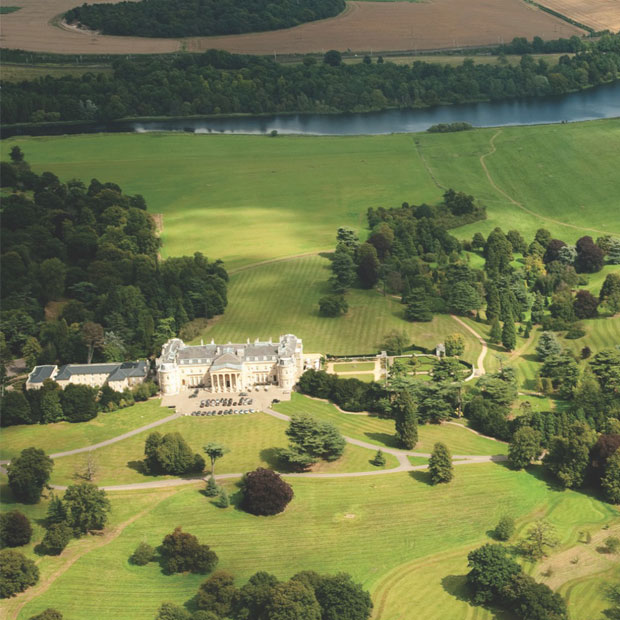Portmarnock Golf Club
One of the world’s most difficult tests of golf, Portmarnock is blessed with a steady dose of wind, some of the firmest conditions anywhere, and a number of world-class holes

Portmarnock Golf Club can trace its origins back to Christmas Eve, 1893. That’s when Scotsman W.C Pickeman, along with Irish pal George Ross, rowed across a narrow estuary from nearby Sutton to a peninsula in Portmarnock occupied by subsistence tenant farmers. Pickeman knew this was prime golf land. The duo negotiated with landlord John Jameson (yes, a member of that Jameson family), who agreed to lease the land. Mungo Park, 1874 Open champion, helped design the front nine, which opened in December 1894. The back nine followed in 1896. The Portmarnock layout has remained in its original footprint since, with no real rerouting work done in the intervening 130 years. There are now 27 holes on the property, with a third nine (par 37) designed by Fred Hawtree opening for play in 1971.
Editor’s note: The author of this profile, Darragh Garrahy, is a member and former greens chair at Portmarnock Golf Club. That makes him terrific source of knowledge on the course’s history and design, but to ensure an objective final review, the Fried Egg Golf team alone was responsible for the final Egg rating and reasoning.
{{content-block-course-profile-portmarnock-golf-club-001}}
Take Note…
Aquifer, “Be Up.” The links is surrounded by water on three sides and drained by an aquifer beneath, meaning that in the winter it can still play almost as firm as many other links do in the summer. With fine sand draining beneath and a playing surface consisting almost entirely of fescue, Portmarnock is renowned for its firmness of play. The club motto is “Be Up,” the irony of which is not lost on those who have seen their ball bounce flag-adjacent while still only beginning its journey. It’s nearly impossible not to “Be Up.”
Outer Lands. With 500+ acres on site, Portmarnock had long thought about developing a further nine holes to make a complement of 36. The club acted on this in the late 1980s, with the course rerouted to include new holes built out on the foreshore, starting across from the third hole and moving around the periphery of the fourth hole. These were exciting holes, but along with other infrastructure they were washed away in a storm soon after opening. The hole corridors and greens are still visible, and the club plays a two-club competition on them once a year called the Outer Lands. When circled by water and wind, you are never inviolate from the whims of nature.
Flippin’ genius. In 1938, Nos. 8 and 10 were simultaneously altered. The old eighth hole played from the present eighth tee to the present 10th green. That made for a short par 4 of 316 yards that presented one of the most demanding pitch shots on the links, up and over the “Valley of Sin,” which still exists to the left of the current 10th green. Imagine playing from the current eighth fairway to the current 10th green! The whole world would be running away from you. Modern green speeds wouldn’t allow it. The old 10th hole, a 319-yard par 4, played from the present forward 10th tee to a green on low ground in front of the current 11th tee. Over the winter of 1937, a new eighth green was built close to the old ninth tee, lengthening No. 8 to 396 yards. The old eighth green was fully retained, becoming the present 10th green. Those changes extended the course from 7,016 to 7,208 yards, and Portmarnock became reputed as “the longest course in the British Isles.”
Favorite Hole
No. 10, par 4, 355-370 yards
The tee shot on this par 4 must hug the fairway bunker on the left to open up the green for the approach, which demands a hold-up fade. Anything left of center of the green will find a home in the left swales, but it’s a better miss than the sheer fall off on the right-hand side.
Favorite Hole
No. 10, par 4, 355-370 yards
The tee shot on this par 4 must hug the fairway bunker on the left to open up the green for the approach, which demands a hold-up fade. Anything left of center of the green will find a home in the left swales, but it’s a better miss than the sheer fall off on the right-hand side.
This Fried Egg Golf Video on volcano holes is a great primer for the 10th green at Portmarnock

{{content-block-course-profile-portmarnock-golf-club-002}}
Overall Thoughts
Portmarnock Golf Club can be summed up in one word: venerable.
It suits the history of the club and the links. One hundred and thirty years old this year, Portmarnock has hosted 88 championships, including 19 Irish Opens and the 1991 Walker Cup. The list of Irish Open winners here from 1986 to 1990 speaks to the examination of skill Portmarnock provides: Seve Ballesteros (1986), Bernhard Langer (1987), Ian Woosnam (1988 and ’89), and José María Olazábal (1990).
Tipping out at 7,500 yards (with the white tees playing to 7,000), Portmarnock is a true ball-striking test. The wind never stays in bed on the Portmarnock peninsula. But even at length and in the wind, charm is still found aplenty.
The course is eminently playable for the higher handicap, which cannot be said of many of the wilder and more dramatic links on the west coast of Ireland. An approach shot can be laid short, as the vast majority of greens are unprotected at the front, and the ground game utilized to make safe bogeys. No. 5 features the only forced carry off the tee, as players contend with a hill on which a Victorian-style bunker used to sit. (Bring it back!) It’s death by a thousand cuts for bogey players as they make their way to the green, but they are most always able to find their ball and advance. Yet Portmarnock remains difficult for the scratch player, with the course’s innate firmness making effective green sizes very small and rendering birdies hard to come by.
This is where Portmarnock shines. Its test is the perfect foil for the subtle links terrain it occupies. The interest is in the micro, not the macro, with small hillocks wreaking outsized havoc on the approaches to the greens. Even well-struck shots that reach greens on the fly must account for the thud of a ball bouncing 10 feet into the air en route to a fate unknown. Rangefinders come second to local knowledge. The ball is always alive at Portmarnock.
The tee box on the first hole is iconic. It’s a 55-yard rectangular strip that slants from front to back. Players can’t see the fairway when teeing off the rear portion. The view consists only of the Baldoyle Estuary right and three pot bunkers left. As you eyeball one of the greatest opening tee shots in golf, just remember: the fairway is wider than you think.

The course opens with three par 4s running in the same southerly direction. The third hole is a standout: dead flat, 390 yards long with the fairway winding in a semi-circle to the left. Miss it and you’ll find either a (generally) dry salt marsh on the right or a gnarly ridge on the left that divides the hole from the fifth green. The approach must clear a cross bunker 30 yards short, which deceptively appears to be set flush up against the green surface. It ties in wonderfully with a low ridge coming down from the left, taking away all depth perception. Of the third, Bernard Darwin said, “[It] admits of no similitude, for it is not like any other that I know of. That long curving narrow strip of turf with benty hills on one side and wet sand on the other.”
Number one on the handicap index, the fourth runs at an easterly right angle from the third. The blind-drive fifth goes in the opposite direction, exposing the player to Portmarnock’s hallmark changing of direction. With the prevailing wind being south-westerly, the course has few holes that play directly upwind or downwind. On the whole course, only No. 4, No. 11, and the tee shot on No. 6 will be aided by a tailwind, while No. 5 is often the only hole playing into the teeth. The sheer variety of crosswinds at Portmarnock may be unique, though perhaps the figure-eight routing at Muirfield (HCEG) is a challenger.
Much is made of the famous finishing stretch at Portmarnock, but my favorite sequence is Nos. 5 through 10. The full spectrum of Portmarnock’s greens is on display here: extension-from-fairway types like the fifth and 11th; greens built into dune ridges, as on the 580-yard sixth (which breaks the run of five opening par fours); and the Dornoch-style raised plateau greens at the eighth and 10th. The latter two are extraordinary, with wonderful run-offs.
The eighth green falls off sharply to the right, such that any ball hitting right of center will likely run down and away. A long bump-and-run approach from the fairway into the eighth green is one of golf’s great pleasures. Going left off the eighth tee can leave you with a 130-yard shot where your best option is actually to lay it 20 yards short of the green, as everything falls away from you severely right of the green. A Pro V1 Left Dash coming in from here may react like a marble on a runway.
After the exceptional eighth, the ninth green is often overlooked by first-time visitors. It appears the ball can be run up on this par 4, but this crumpled approach swings hard right to left, offering an almost Redan-like quality to the slopes in front of the green. Bunkers on the right keep you honest and pull you to the left. In true Portmarnock style, a ball ending up there will offer myriad recovery options from firm, closely mown turf.
The par-3 12th green has a baleful look and plays the same way, with balls getting rejected on all sides unless players hit a handful of flat spots with requisite control. The only bail-out area is the back hollow through the green, which provides a puttable sanctuary. The back-right portion of the green came into being after a Martin Hawtree renovation in the early 2000s, which intended to make the 148-yard hole a sterner test with more pinnable locations. The hole is far from homogenous with the rest of the course, and some would say this injection of wildness is good for a course which, in general, is quite equitable.

The 14th begins the closing stretch, of which Darwin said, “I know of no greater finish in the world than that of the last five holes at Portmarnock.” This dogleg-left par 4 is often played with the prevailing wind over the right shoulder. Longer hitters can get right down to the front of the green, leaving an uphill pitch from 60 yards to a tabletop green. The play is often to the middle of the putting surface, regardless of the pin.
Adjacent to the Irish Sea, Portmarnock’s 15th is both the course’s most famous hole and one of the greatest par 3s in world golf. It was actually added to the routing in 1926 by the benevolent dictator of Portmarnock, Guppy Cairnes, some 32 years after the course had opened. This hole plays 170-190 yards on account of its long green. A steep fall-off left has collected many balls, and tempts a flop shot recovery like Phil Mickelson’s at the 1991 Walker Cup. My only criticism is that the second bunker on the left-hand side of the green can gather balls up against its side wall due to its orientation, stopping them from flowing into the valley on the left. However, two bunkers on the left and one on the right creates a nicely asymmetrical look.
{{content-block-course-profile-portmarnock-golf-club-003}}
The 17th is a straight, austere, and formidable par 4, demanding two well-struck shots to get over a ridge 30 yards short of the green. No. 18, the sole left-to-right dogleg on the course, used to be a par 5 finishing on what is now the practice green. It’s been updated to a par 4 requiring a short iron from the top of a hill to a raised green. With the striking clubhouse in the background, it is a hole that feels a little different from the rest, with an almost amphitheater-style green.
The 18th green marks the end of a journey, one that some don’t appreciate on a first play. Those that do, however, never stop thinking about the experience.
2 Eggs
(Egg rating determined by Fried Egg Golf’s editorial team)
While not as dramatic as some other standout courses of the Emerald Isle (Royal County Down, Royal Portrush, and Lahinch, for instance), Portmarnock is blessed with extraordinary natural assets. The point on which the course sits ensures a steady dose of wind, and the sandy soil base promotes some of the firmest, if not the firmest, conditions anywhere. When the wind is up and the turf is running, Portmarnock’s elegant, understated design elements work quite well. This is naturally one of the world’s most difficult tests of golf despite never looking all that hard. Each nine features a number of world class holes, though many of these would be greatly improved with mowing lines that embrace the course’s original width. As it is, though, Portmarnock is one of the finest golf clubs in Ireland or Great Britain and a must-visit for any trip that starts in Dublin. -Andy Johnson
Course Tour

{{content-block-course-profile-portmarnock-golf-club-004}}
Leave a comment or start a discussion
Get full access to exclusive benefits from Fried Egg Golf
- Member-only content
- Community discussions forums
- Member-only experiences and early access to events







Leave a comment or start a discussion
Lorem ipsum dolor sit amet, consectetur adipiscing elit. Suspendisse varius enim in eros elementum tristique. Duis cursus, mi quis viverra ornare, eros dolor interdum nulla, ut commodo diam libero vitae erat. Aenean faucibus nibh et justo cursus id rutrum lorem imperdiet. Nunc ut sem vitae risus tristique posuere. uis cursus, mi quis viverra ornare, eros dolor interdum nulla, ut commodo diam libero vitae erat. Aenean faucibus nibh et justo cursus id rutrum lorem imperdiet. Nunc ut sem vitae risus tristique posuere.